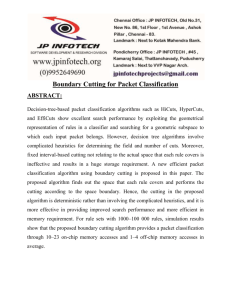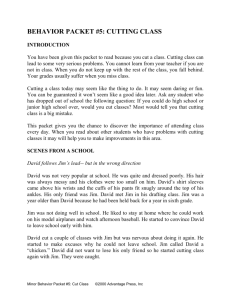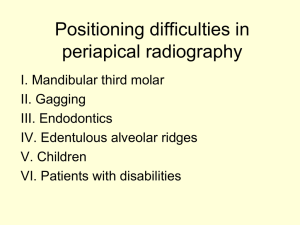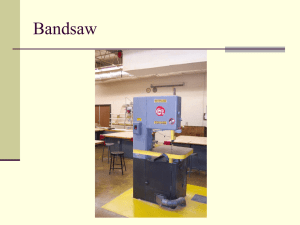PowerPoint **
advertisement
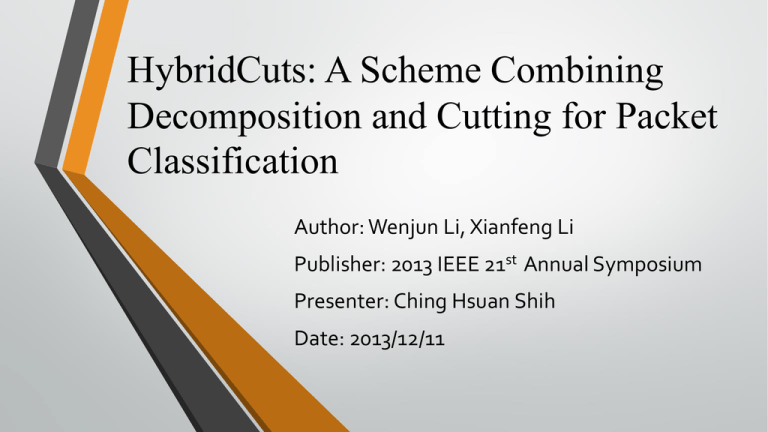
HybridCuts: A Scheme Combining
Decomposition and Cutting for Packet
Classification
Author: Wenjun Li, Xianfeng Li
Publisher: 2013 IEEE 21st Annual Symposium
Presenter: Ching Hsuan Shih
Date: 2013/12/11
Outline
I. Introduction
II. Background
III.Related Work
IV.HybridCuts
V. Experimental Results
I. Introduction
Two major approaches to packet classification:
• Architectural: TCAM
• Advantage: process packets at line speed
• Disadvantage: expensive, high power consumption, rule duplication
• Algorithmic:
• Decision-tree: Hicuts, HyperCuts, and EffiCuts
• Decomposition: BV
I. Introduction (Cont.)
Proposed scheme:
• HybridCuts: a combination of decomposition and decision-tree
techniques
• A rule set decomposition algorithm based on the observation that most
rules have at least one small field.
• A novel one-dimensional cutting algorithm called FiCuts.
• A two-stage cutting framework which combines one-dimensional cutting
and multi-dimensional cutting techniques.
II. Background
A. The Packet Classification Problem
• To find a matching rule from a packet classifier for a packet.
• A classifier is a set of rules, with each rule R consisting of a tuple
of F field values, and an action to be taken in case of a match.
II. Background (Cont.)
B. Complexity in Theory
• From a geometric point of view, for N non-overlapping hyperrectangles in F-dimensional space:
• The best bounds for locating a point are either Θ(log N) time with Θ(NF)
space, or Θ(logF-1 N) time with Θ(N) space.
• Impractical: with just 1000 rules and 4 fields, a solution is either
impracticably (NF is about 1000G) or too slow (logF-1 N is about 1000
memory accesses).
II. Background (Cont.)
C. Complexity in Practice
• It is infeasible to design a single algorithm that can perform well in all cases.
• Packet classification rules in real-life have some inherent characteristics that
can be exploited to reduce the complexity.
•
•
•
•
•
The protocol field is restricted to a small set of values.
Rules specify a limited number of distinct transport port ranges.
The number of address prefixes matching a given address is typically five or less.
The number of rules matching a given packet is typically five or less.
Many different rules share the same field values.
III. Related Work
A. Parallel Bit-Vector (BV)
• One of most representative decomposition based solutions.
• It works on the individual fields of rules independently for partially
matching results.
• Then a bit-wise AND operation on all bit vectors is performed to get
the final result.
III. Related Work (Cont.)
III. Related Work (Cont.)
B. HiCuts and HyperCuts
• Take a geometric view of the packet classification problem.
• HiCuts chooses one dimension to cut at one time.
• HyperCuts chooses multiple dimensions to cut at one time.
III. Related Work (Cont.)
C. EffiCuts
• Separate rule set into several subsets, depending on whether the
value of each dimension is wildcard (or almost wildcard).
• Each subset creates its own decision-tree independently using
HyperCuts.
III. Related Work (Cont.)
D. ParaSplit
• Employs a complex heuristic for rule set partitioning.
• It is different from EffiCuts in that its objective is for efficient
hardware implementation using FPGAs.
IV. HybridCuts
A. Decomposition-based Framework
Definitions:
• Given an N-dimensional rule R = (F1, F2, F3, …, FN), Leni represents the length of
field Fi , and a threshold value vector T = (T1, T2, T3, …, TN).
• We call Fi is a small field if Leni≦Ti. Then we define the following concepts for R:
•
•
Big rule: ∀i ∈{1, 2, 3 ... N}, Fi in R is a big field
Small rule: ∃i ∈{1, 2, 3 ... N}, Fi in R is a small field
IV. HybridCuts (Cont.)
• We decompose a 5-tuple rule set into the following five subsets without
duplicates among each other:
•
•
•
•
•
1. Big-subset: SA, DA, SP and DP are all big field
2. SA-subset: SA is a small field for each rule
3. DA-subset: DA is a small field for each rule
4. SP-subset: SP is a small field for each rule
2. DP-subset: DP is a small field for each rule
• When processing a rule R with two small fields: SA and DA, suppose the sizes of
the SA-subset and the DA-subset up to now are N1 and N2 respectively, then rule
R will go to SA-subset if N1≦N2, or to DA-subset vice versa.
IV. HybridCuts (Cont.)
IV. HybridCuts (Cont.)
B. FiCuts: A One-Dimensional Cutting Technique
• Simplicity: FiCuts conducts cuttings on the subset along a fixed dimension
• Adaptivity: FiCuts can decide when to stop FiCuts and resort to other more
effective cutting methods
How to decide np:
spfac * number of rules at node r ≥ ∑ number of rules at each child of node r + np
IV. HybridCuts (Cont.)
binth = 4
spfac = 2
IV. HybridCuts (Cont.)
C. Multi-dimensional Cutting
• With the shrinking of the search space, rule replications begin to rise with fine cuts.
• FiCuts makes the decision. If the number of cuts np at a node is less than a
predefined MAXCUTS, FiCuts resorts to HyperCuts
IV. HybridCuts (Cont.)
binth = 2
spfac = 2
IV. HybridCuts (Cont.)
D. Optimization
• Most rules have at least one small IP address field (SA or DA).
• Based on this observation, we reduce the number of decision trees. For a 5-tuple
rule set, we decompose it into three subsets:
•
•
•
1. Big-subset: Both SA and DA are big field
2. SA-subset: SA is a small field for each rule
3. DA-subset: DA is a small field for each rule
IV. HybridCuts (Cont.)
Depends on SA, DA, SP, and DP
Depends on SA, and DA
V. Experimental Results
A. Memory Consumption
V. Experimental Results (Cont.)
A. Memory Accesses
V. Experimental Results (Cont.)
C. Potential of Parallelization
• It can be seen that in most cases, the worst-case height of a single tree is half of or
less than the overall number of memory accesses on all the trees. This means that
the trees constructed are balanced in height among each other, amenable to a
parallel implementation with a potential 2x speedup.
